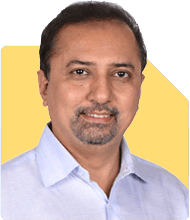Dear Mr. Kalirajan, My Name is Ajay aged 53, i left my job a year ago due to some health issues and do not intend to rejoin again. i have my own house along with a saving of 2.10 CR mainly in MF, Bank FD and direct equity in proportion of 60% Equity and 40% Debt. I have one daughter in class 12th and have earmarked a sum of 50 Lacs for her education invested 50:50 in Debt and equity. with remaining 1.60CR how can i generate an income of one lac Per month. i Am adequately covered in terms of health and life Insurance and also i receive Rs.10000 per month from a pension plan. Your Valuable suggestion will be really helpful. Regards, Ajay
Ans: Assessment of Current Financial Situation
Ajay, it is commendable that you have a well-structured portfolio, especially considering your early retirement due to health reasons. Your current savings of Rs. 2.10 crore, with a 60% allocation to equity and 40% to debt, provides a solid foundation. Additionally, you’ve set aside Rs. 50 lakhs for your daughter’s education, reflecting a thoughtful approach to future needs.
You aim to generate a monthly income of Rs. 1 lakh from your remaining corpus of Rs. 1.60 crore, which will supplement the Rs. 10,000 you receive from your pension plan. Given the current structure of your investments, a well-balanced strategy can help achieve this goal while preserving your capital.
Evaluating the Existing Portfolio
Your portfolio is currently divided into 60% equity and 40% debt. While equity offers potential for growth, debt ensures stability. However, given your goal of generating a stable monthly income, it’s essential to reassess this allocation. At 53, with no intent to rejoin the workforce, preserving your capital and generating a regular income should take precedence over aggressive growth.
Equity Exposure: While equity investments are essential for growth, they come with volatility. A 60% exposure may be higher than necessary for your current income needs. It may be wise to reduce this to 40-50%, ensuring that you can still benefit from growth while reducing risk.
Debt Allocation: Your 40% debt allocation provides stability. This can be further optimized to ensure it generates steady income. By including more conservative debt instruments, you can enhance income generation without taking on excessive risk.
Strategies to Generate Rs. 1 Lakh Monthly Income
Your goal of Rs. 1 lakh per month can be achieved by carefully structuring your investments to provide regular income. Let’s explore how to achieve this:
Systematic Withdrawal Plan (SWP): An SWP from your mutual funds can provide a regular monthly income. By withdrawing a fixed amount each month, you can ensure a steady cash flow while your investments continue to grow. It’s advisable to set up SWPs from both your equity and debt mutual funds, ensuring a balanced approach.
Fixed Deposits (FDs) and Debt Funds: A portion of your Rs. 1.60 crore can be allocated to FDs and debt funds that offer monthly or quarterly interest payouts. This will provide a reliable income stream, supplementing your SWP. Debt funds, in particular, offer tax efficiency, especially for long-term holdings.
Balanced Advantage Funds: These funds automatically adjust between equity and debt based on market conditions. They offer the dual benefit of growth and stability. By investing in these, you can enjoy a balanced approach that aligns with your income needs.
Senior Citizen Savings Scheme (SCSS): Although you are not yet eligible, it’s worth considering for future years when you turn 60. SCSS offers a stable income with attractive interest rates, suitable for retirees.
Rebalancing Your Portfolio
Given your current situation, it’s crucial to rebalance your portfolio to align with your income goals. Here’s how:
Reduce Equity Exposure: Lower your equity exposure to 40-50%. This will reduce the volatility in your portfolio, ensuring that you are not forced to sell assets at a loss during market downturns.
Increase Debt and Income-Oriented Investments: Allocate a larger portion of your portfolio to debt instruments that provide regular income. This will help in generating the required Rs. 1 lakh per month.
Diversification: Ensure that your investments are diversified across various asset classes. This reduces risk and provides a more stable return. Consider adding some conservative hybrid funds or balanced advantage funds to your portfolio.
Addressing Education Funding
You’ve wisely earmarked Rs. 50 lakhs for your daughter’s education, split evenly between debt and equity. This strategy is sound, but given that your daughter is in 12th grade, you may need to re-evaluate the equity portion.
Shift to Conservative Investments: As your daughter approaches college, it might be prudent to gradually shift a portion of the equity investments into more conservative debt instruments. This ensures that the funds are available when needed without the risk of market fluctuations.
Education Loans: If necessary, consider an education loan to cover any shortfall in funds. This can be a strategic move, allowing you to preserve your investments while benefiting from the tax advantages on education loan interest.
Managing Risks and Ensuring Stability
Your health issues have already influenced your decision to retire early. It’s essential to consider the following to manage risks and ensure financial stability:
Emergency Fund: Maintain an emergency fund equivalent to 12 months of expenses. This ensures that you have immediate liquidity in case of unexpected expenses.
Insurance Coverage: You’ve mentioned being adequately covered in terms of health and life insurance. Ensure that your health insurance provides comprehensive coverage for you and your family. Given your early retirement, also consider a critical illness rider if not already included in your policy.
Inflation Protection: Ensure your investments are inflation-protected. While debt instruments provide stability, they often lag behind inflation. Hence, a portion of your portfolio must still be allocated to growth-oriented assets like equity.
Tax-Efficient Withdrawal Strategy
Generating Rs. 1 lakh per month also requires a tax-efficient strategy. Here’s how you can minimize taxes on your withdrawals:
Long-Term Capital Gains (LTCG): Utilize the tax benefits of LTCG on equity investments. By systematically withdrawing gains, you can stay within the tax-free limit of Rs. 1.25 lakh per year.
Tax-Advantaged Debt Funds: Consider debt funds that offer indexation benefits, reducing the tax burden on your withdrawals.
Avoid Early Withdrawals: If possible, avoid withdrawing from investments before they have reached a tax-advantaged status. This will help minimize taxes and maximize your income.
Final Insights
Ajay, your current financial situation is strong, with a well-balanced portfolio and a clear goal. By slightly adjusting your asset allocation and focusing on income generation, you can comfortably achieve your target of Rs. 1 lakh per month.
Ensure that your portfolio remains diversified and rebalanced periodically. This will help you manage risks while enjoying a steady income. Your daughter’s education is well-covered, but a shift towards more conservative investments as she nears college would be prudent.
With these adjustments, you can enjoy a worry-free retirement with a stable income stream that meets your needs.
Best Regards,
K. Ramalingam, MBA, CFP,
Chief Financial Planner,
www.holisticinvestment.in




























